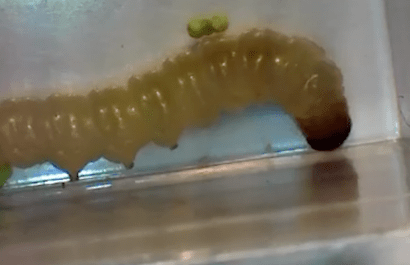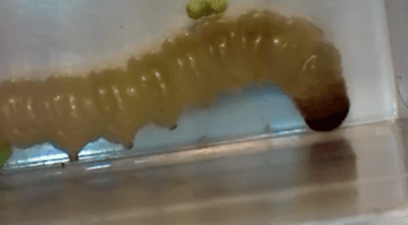An Indianmeal Moth Larvae
Indianmeal moth larvae are one of the most common pantry pests found in homes, also known as store product pests. They can infest foods very quickly. Indianmeal moth larvae are usually introduced to your home by bringing in contaminated food products and packaging, including pet food, nuts, dried fruits and bird seeds to the house. The adult moths are small and brownish-grey in colour, with a distinctive band of bronze or copper-coloured markings on their wings. The larvae of the Indian meal moth are small, cream-coloured caterpillars with brown heads.

Life Cycle of the Indian Meal Moth
Once inside the home, Indian meal moths can lay their eggs on food products or in crevices and cracks in the pantry or kitchen. The eggs hatch into larvae, which feed on the food products and can cause contamination and spoilage. The life cycle of the Indian Meal Moth is egg, larvae, pupa then adult. A female moth can lay anything up to 400 eggs at a time and they hatch in 7 days. The eggs produce a caterpillar type larvae, which develops over 6 to 8 weeks. The pupa stage lasts 2 to 3 weeks. The larvae makes a webbed home for the cocoon. Adult moths don’t feed so only last for two weeks, they do however mate which starts the cycle again.
What do Indianmeal Moths Eat?
Indianmeal moth larvae are general surface feeders, they feed on grains, grain products, dried fruits, nuts, cereals, and a variety of processed food products. In addition the larvae are capable of chewing through thin plastic bags and cardboard.
Signs of Indian Meal moth
There are several signs to look out for if you think you may have an Indian meal moth infestation including:
- Adult Indian meal moths may be seen flying around the kitchen or pantry, particularly in the evening or at night.
- The larvae of Indian meal moths may leave behind silken webbing in the food products they infest.
- Small, cream-colored larvae with brown heads may be visible in infested food products.
- Infested food products may have a musty odor, and may contain live or dead insects, webs, or droppings.
Are Indianmeal Moth Dangerous?
Indianmeal moths are not dangerous as they do not carry diseases or parasites. The biggest threat they pose is of infestation and contamination of food in which they infest. They encourage the growth of mold, leave behind webbing and feces in products, and change the flavor of foods they infest. Those who encounter problems with Indianmeal moths must throw away infested items, which may result in large amounts of waste.
Business Reputation
If you own a business such as a pet food store or in food production of a dried produce this pest can be a challenge. Pest-Tech has had to deal with the control of this store product pest on many occasions in this environment. This pest can ruin reputation and loose business if not dealt with swiftly. To prevent Indian meal moth infestations, it’s important to store food products in airtight containers and to inspect stored food products regularly for signs of infestation. Infested food products should be discarded, and the pantry or kitchen should be thoroughly cleaned to remove any potential breeding sites for the moths.
If an infestation is suspected, it’s important to contact a professional pest controller to properly identify the pest and develop a targeted treatment plan. Our pest control services are available, Pest-Tech Ltd is a member of the BPCA. If you need help or advice then Pest-Tech Ltd can supply a treatment plan to deal with your infestation. Contact Us to find out more.
